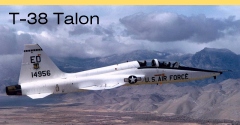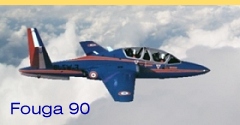The
![]() Design Process
Design Process
The process of designing something is a progressive exercise. I start by taking a “first cut” at it and then build from there. Sometimes during the process, new information becomes available that affects the design. The HawkJET™ has definitely fit this scenario. The HawkJET™ is now “version 5.0”, or as I call it, the HawkJET™ V (for obvious reasons).
Because it was mainly the ViperJet that got me started this direction, the “first cut” was similar in many ways – single turbojet engine, tandem seating, etc. As I studied the details I discovered the engine being used was much larger that what was really needed. I looked for something smaller and found the TRS 18 turbojet – the same engine used in the BD-5J. It was definitely smaller, so small in fact that it would take two of them to provide the thrust I wanted to power the HawkJET™, making it a nice little "TwinJet".
I then learned that since the TRS 18 turbojet is an old and simple design primarily intended for military drones, it has no facility for “bleed air” to be used for cabin pressurization. Also, being a pure turbojet, it is very thirsty. This would leave the HawkJET™ with cumbersome oxygen bottles and masks for the crew, and only four or five hundred mile range.
 The
HawkJET™
“version 3.0” was then designed around the new Pratt & Whitney turbofan engine being developed for the
Eclipse 500 six seat business jet. There are potentially two other engines I found in this class that could
be used also. I soon discovered that these engines might be difficult to acquire because they are only made
available to companies developing or currently building FAA Certified aircraft. There are no current plans
to certify the
HawkJET™.
The
HawkJET™
“version 3.0” was then designed around the new Pratt & Whitney turbofan engine being developed for the
Eclipse 500 six seat business jet. There are potentially two other engines I found in this class that could
be used also. I soon discovered that these engines might be difficult to acquire because they are only made
available to companies developing or currently building FAA Certified aircraft. There are no current plans
to certify the
HawkJET™.
Williams International introduced the FJ44 TurboFan for the Cessna Citation CJ1 and has subsequently delivered more than one thousand of them over the years. This engine has therefore been sold in sufficient quantities to be available on the ‘used’ market so the current plan is to purchase a used FJ44 with plenty of usable life remaining to power the HawkJET™ for several years. However this engine is a little larger so “version 4.0” grew slightly to accommodate it. The wing area was increased by ten square feet and the span by two and a half. In the process, the fuselage was made somewhat longer and wider and provides a roomier cabin for added comfort for the crew.
It was not an easy decision to use an engine that would cause the HawkJET™ to have to get larger. Fortunately the increase in size was minor. Since the FJ44 is a TurboFan, the biggest need was to allow for the larger size and weight of the engine itself. The fuel load requirements to upgrade in engine size are also relatively minor. Based on the likelihood of limited availability of the newer TurboFans, it seems this avenue will ensure the HawkJET™ will have an engine. Even with this step up in size, the HawkJET™ still retains its advantages over the older pure turbojet engines.
With this increase in size, the wetted area of the HawkJET™ “version 4.0” is almost 17% greater than “version 3.0”. This extra area reduces the predicted cruise speed from 350 knots to about 333 (at the same fuel flow). I wanted to do better and investigated using a V-tail. After modeling the HawkJET™ with a V-tail and with a conventional tail, it turned out the V-tail has slightly less wetted area mostly because it alters the shape of the tailcone. This plus additional work on the turtledeck and empenage brought the wetted area down even further. As a result, the wetted area of “version 5.0” is now only 12% more than the wetted area of “version 3.0” (with almost all of this extra area due to the increase in cabin volume). Therefore, the predicted cruise speed at the same fuel flow is 337 knots. Actually, it’s the HawkJET™ “version 5.3” as it took a few iterations to whittle down the wetted area to this point.
 The fuselage shape is inspired by
the T-38 Talon supersonic jet trainer. I have always considered the T-38 one of the most appealing jets in
terms of styling and you can see its influence in the forward fuselage and canopy of the
HawkJET™.
The canted twin tails of the F/A-18 are what originally got me to look toward a V-tail configuration because
I like that look. Plus I like the appearance of the tail on the Fouga Magister and the prototype Fouga 90.
The '90 is another one of those jets with a very appealing shape and its influence shows in the
The fuselage shape is inspired by
the T-38 Talon supersonic jet trainer. I have always considered the T-38 one of the most appealing jets in
terms of styling and you can see its influence in the forward fuselage and canopy of the
HawkJET™.
The canted twin tails of the F/A-18 are what originally got me to look toward a V-tail configuration because
I like that look. Plus I like the appearance of the tail on the Fouga Magister and the prototype Fouga 90.
The '90 is another one of those jets with a very appealing shape and its influence shows in the
 HawkJET™
also. Many have commented or questioned the flying qualities of choosing a V-tail. This is apparently due to
the Dutch Roll characterisitcs of the V-tail Bonanza. The flying qualities of the Bonanza are the result of
poor execution of a sound principal not the other way around. A testiment to this is that the Fouga Magister
does not demonstrate any of the unfavorable characteristics of the V-tail Bonanza.
HawkJET™
also. Many have commented or questioned the flying qualities of choosing a V-tail. This is apparently due to
the Dutch Roll characterisitcs of the V-tail Bonanza. The flying qualities of the Bonanza are the result of
poor execution of a sound principal not the other way around. A testiment to this is that the Fouga Magister
does not demonstrate any of the unfavorable characteristics of the V-tail Bonanza.
I use “V” for Roman Numeral Five (for version five) plus it also reflects the V-tail configuration. I really like the new look of the HawkJET™ V! I have frozen the design at this point since the HawkJET™ V has handled all the previous design concerns. I am very pleased with where the design has ended-up and there are no major outstanding design issues left to deal with.